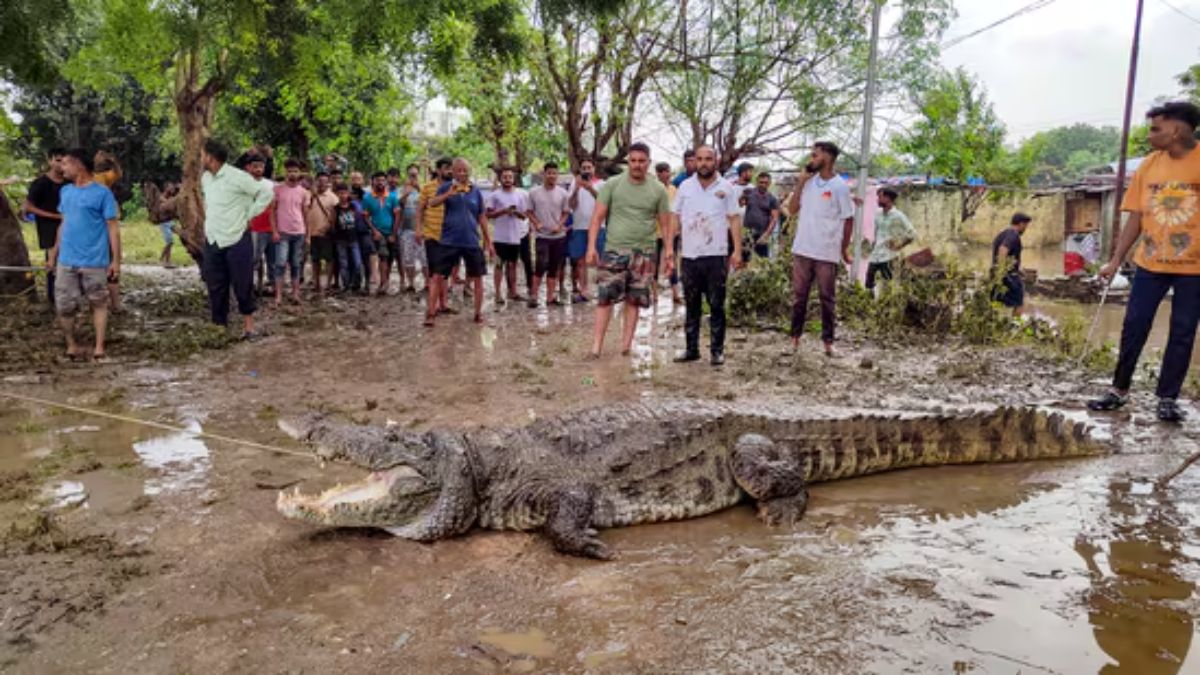Vadodara, a city already grappling with unprecedented floodwaters, now faces a new challenge: a crocodile invasion.
The relentless rain in Gujarat has submerged the city, turning streets and homes into flood zones. But the rising water levels in Vishwamitri River have done more than just disrupt daily life—they’ve also driven hundreds of formidable reptiles into the residential areas.
Several crocodiles, measuring 10 to 15 feet, have been spotted on the roads, parks, outside residences, and even on roofs of homes, causing panic among residents.
Here’s what we know of the situation
Crocodiles on the move
Vadodara is grappling with severe flooding, particularly in its low-lying areas, and the crisis is escalating with the arrival of crocodiles.
The Vishwamitri River, which stretches 17 kilometres through the city, is home to mugger crocodiles. Recent reports indicate that many of these reptiles have been swept into the city by the floodwaters.
A video shared on X shows a massive crocodile prowling near the riverfront, while another clip captures a crocodile perched on the roof of a house in the submerged Akota Stadium area.
Impact Shorts
More ShortsAdditionally, an 11-foot mugger crocodile was rescued from the Maharaja Sayajirao University of Baroda after it ventured in from the Vishwamitri River.
“Vadodara is facing a double threat with both floods and crocodile sightings. As the Vishwamitri River overflows, crocodiles are seen venturing into various human settlements across the city,” an X user wrote in the post.
An official reported on Thursday that they have rescued 10 crocodiles in the past five days.
“Two have been released, and eight are still with us. We will release them when the water level of the river decreases,” the official told news agency ANI.
Earlier on Tuesday morning, the river breached the 25-foot danger mark. This has led to the evacuation of over 3,000 residents from low-lying areas around Vadodara. The river’s level has now risen to over 34 feet with no immediate signs of retreat.
For those living along the river’s banks, crocodile sightings are nothing new.
Every monsoon season, these reptiles leave the safe confines of the river and make their way into the city’s residential areas aided by flooded streets.
“While rescue of crocodiles from residential areas near the bank of Vishwamitri river continues throughout the year, the number rises significantly during monsoon,” the PTI news agency quoted Range Forest Officer (RFO) Karansinh Rajput as saying.
In June, four crocodiles were rescued and released back into the river, he said, adding the number rose sharply to 21 in July, highlighting the scale of the challenge posed by these seasonal invasions.
Why does Vishwamitri River have so many crocodiles?
The Vishwamitri River flows from East to West, situated between the larger perennial rivers Mahi and Narmada.
Kartik Maharaj, the deputy conservator of forests (DCF) in Vadodara, explained in a Times of India report that the Narmada River hosts a significant population of crocodiles, which often navigate through a vast network of irrigation canals.
These crocodiles venture into the canals, eventually settling in ponds across different talukas, with many migrating from one waterbody to another via these canals.
Over the years, the crocodile population in the Vishwamitri River has steadily increased. The most recent census in 2021 counted 1,000 crocodiles in the river, a significant rise from 250 in 2015.
“The numbers have gone up in the latest census as crocodiles staying in Vishwamitri River have no natural enemy. They have adapted to the environs and get enough food too,” Maharaj noted.
Officials involved in the census said Vadodara easily has the highest number of crocodiles among all districts of Gujarat.
A study published in the International Journal of Scientific Research in Biological Sciences found that reptiles have developed potent antimicrobial abilities within their immune systems or gut microbiomes. This adaptation helps them successfully combat the bacteria in the polluted river, allowing them to thrive despite the heavily contaminated environment.
With input from agencies
)